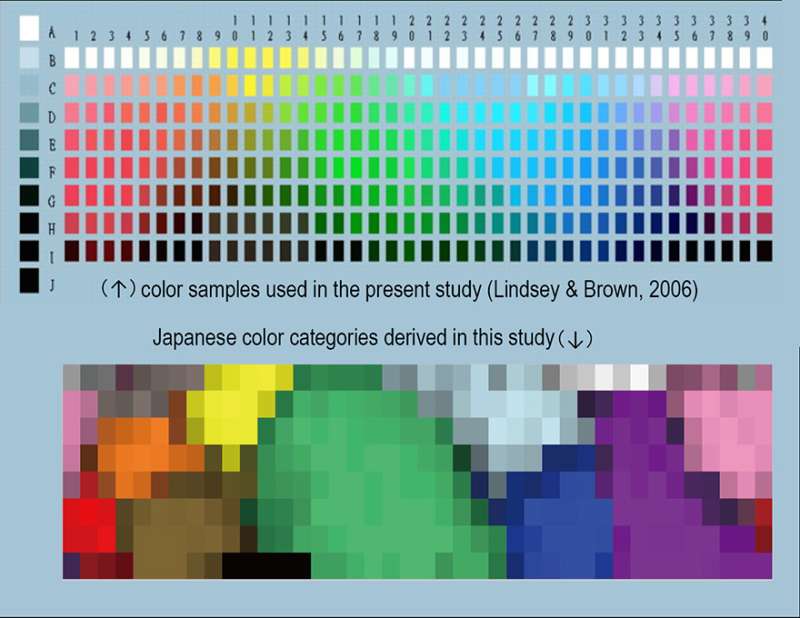The evolution of Japanese color vocabulary over the past 30 years

Color plays an important role in conveying visual information. For example, color can help the observer find an object in a cluttered environment. Although the human eye can distinguish millions of colors, human languages have only a few color terms, such as "red," "green," "blue" and "yellow," which speakers can use to communicate about colors in everyday life. These color terms change over time as a language evolves, and the Japanese language is no exception.
This became clear through the work of an international collaboration between researchers at Tohoku University, their colleagues at Tokyo Institute of Technology and Ohio State University.
The researchers investigated the number of color categories (such as aka, midori, ao, ki, etc.) that are commonly used by native Japanese speakers. They asked 52 participants to name 320 color samples of various hues and lightness (plus black, white and several grays) using only single color words without modifiers (no "greenish yellow" or "light purple").
Statistical analysis of the results revealed 19 common Japanese categories. There were the 11 basic color categories common to most modern industrialized cultures (red, green, blue, yellow, purple, pink, brown, orange, white, gray and black), plus eight additional named color categories. These were: mizu ("water")/light blue, hada ("skin tone")/peach, matcha ("ceremonial green tea")/yellow-green, oudo ("mud")/mustard, enji/maroon, yamabuki ("goldflower")/gold and cream. Of these additional terms, mizu was used by 98% of informants, making it a strong candidate for a 12th Japanese basic color category.
Thirty years ago, a study of Japanese color categories (Uchikawa & Boynton, 1987) did not reveal mizu as a basic color category, because the informants in that earlier study often used mizu ("water") and ao (blue) interchangeably. Conversely, Uchikawa & Boynton found that kusa ("grass") was a very popular term for yellow-green, whereas, in the present study, kusa has been largely replaced with matcha ("ceremonial green tea"). These results illustrate that color terms, like many other aspects of language, change over time.
In contrast to these recent changes, there is one tradition that has not changed over the past millennium: the mixed use of green and blue. Careful study of classic Japanese poems before the 10th century showed that ao ("blue") was used to name both things that were clearly blue and also things that were clearly green; the same was true of midori ("green"). Even today, modern Japanese people refer to the color of the green traffic light, lush green leaves and green vegetables, as ao ("blue"). However, the use of ao and midori are otherwise quite distinct.
The transition from a single category encompassing both blue and green ("grue") to distinct blue and green categories is considered to be a landmark in the typical evolution of color lexicons around the world. For example, the Middle English term "hwen" was used to denote a grue category until 13th century, but modern English, like modern Japanese, has distinct terms for separate blue and green color categories. These investigators showed that, in addition to distinct color terms for blue and green, modern Japanese has recently added a new intermediate color term "mizu" for lighter bluish and greenish samples.
This study showed that although modern Japanese is not a "grue" language - since blue and green are distinct color categories - Japanese people have nonetheless retained traditional expressions from the classic poetic tradition of a thousand years ago.
More information: Ichiro Kuriki et al, The modern Japanese color lexicon, Journal of Vision (2017). DOI: 10.1167/17.3.1
Journal information: Journal of Vision
Provided by Tohoku University



















